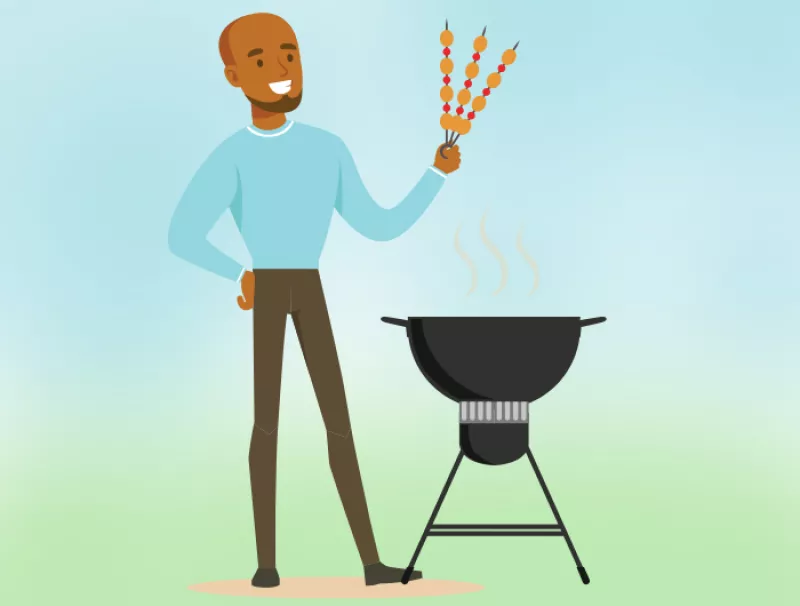Safe and healthy grilling tips

Jorge Bach/CSPI (grill & utensils), warmworld/stock.adobe.com (flame).
Summertime is grilling time...and not just for meat. Here’s how to avoid some common pitfalls and make sure your food is safe, healthy, and grilled to perfection.
Shopping
- Mechanically tenderized beef is labeled so that you know which pieces can be cooked medium-rare (only “intact” meats). If you see “mechanically,” “blade,” or “needle” tenderized on the label, the pieces need to be cooked thoroughly so that even the middle of the cut reaches the proper cooking temperature, just like ground beef.
- Look for meats that were raised without antibiotics. The overuse of antibiotics in the meat industry has led to “superbugs” that can infect humans and are drug resistant.
Prep and cleaning
- Thaw meat either in water heated up to at least 100˚ (for cuts that are about 1” thick) for about 10 minutes or in the refrigerator. Don’t leave frozen meat to thaw at room temperature (on the counter or in the sink).
- Do not rinse meat, especially in the sink, since bacteria can contaminate other surfaces in the kitchen.
- Use a different cutting board to trim raw meats and prepare fresh produce. The only time it is ever safe to chop raw vegetables on the same cutting board after holding raw meat is if you are cooking those veggies along with the meat.
- Before cooking, heat the grill on high with the lid closed until very hot. Then brush the grates clean and use a folded paper towel held with long tongs to apply a thin layer of a neutral oil that’s good at high temperatures (like peanut or canola).
Marinate
- Cooking meat, poultry, or fish at high temperatures can create heterocyclic amines (HCAs), which cause cancer in lab animals. Marinating before grilling slashes HCAs.
- To prevent food poisoning, thaw and marinate meat in the refrigerator, and don’t brush leftover marinade onto the meat while it’s cooking.
- Acids can make meat mushy. Don’t marinate with acidic marinades for more than 20 minutes.
Avoid flare-ups
Polycyclic aromatic hydrocarbons (PAHs) are carcinogens that form when fat or juices drip onto the fire and create flames and smoke. The PAHs in the smoke can stick to the food.
To create fewer PAHs, trim meat of all visible fat and move food away from the heat source (push the coals to the side or turn off the burner that’s directly under the food).
To block smoke and flames, try putting foil over the grates. (Don’t wrap the food in foil; that will steam it.)
Switch it up
- Don’t serve grilled meat, poultry, or fish with the same tray or utensils you used when they were raw.

Check for bristles
- Using a wire brush to clean your grates? Check the grill closely before cooking. Between 2002 and 2014, an estimated 1,700 Americans ended up in the emergency room after swallowing wire bristles that were stuck to grilled food.
Pick plants
- HCAs don’t form in fruits, vegetables, or plant-based burgers, franks, and sausages.
- Think outside the onion. If you’ve never grilled pineapple, peaches, edamame, or zucchini, you’re in for a real treat.
Meat: mind the temperature
- The more well-done or charred the meat is, the more HCAs it will have.
- Use an instant-read food thermometer to make sure the thickest parts reach a safe temperature. That means:
- Chicken: 165º
- Beef, pork, lamb (ground): 160º F
- Beef, pork, lamb (steaks or chops): 145º F
- Fish: 145º F (or until the flesh is opaque and separates easily with a fork)
- To prevent chicken and fish from overcooking, start them on the hot side of the grill, then flip them over to a cooler spot to slow down the cooking.
Keep it cool
- Keep your cooler in the shade.
- Refrigerate leftovers promptly. Discard food that has sat out for more than 2 hours (1 hour if the outside temperature is above 90º F).
Support CSPI today
As a nonprofit organization that takes no donations from industry or government, CSPI relies on the support of donors to continue our work in securing a safe, nutritious, and transparent food system. Every donation—no matter how small—helps CSPI continue improving food access, removing harmful additives, strengthening food safety, conducting and reviewing research, and reforming food labeling.
Please support CSPI today, and consider contributing monthly. Thank you.
Tags
Topics
The latest healthy eating news
Going flexitarian? Here's our guide.
Sustainability

Which plant-based yogurts are healthy and higher in protein?
Healthy Eating

13 foods with more salt, sugar, or fat than you might expect
Healthy Eating

Healthy bread: How to decode labels and buy a better loaf
Healthy Eating

What’s in season: March produce guide
Healthy Eating
By M.M. Bailey


